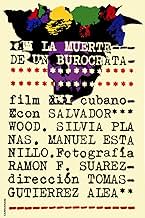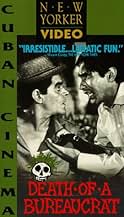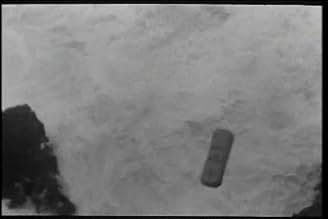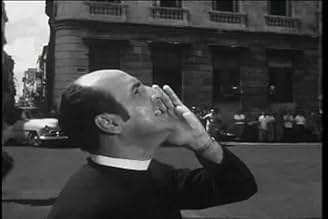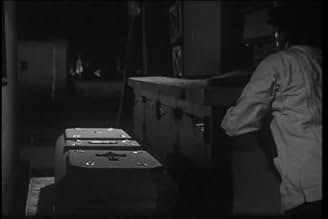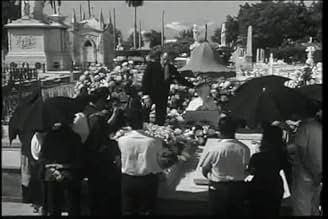IMDb रेटिंग
7.6/10
1.6 हज़ार
आपकी रेटिंग
अपनी भाषा में प्लॉट जोड़ेंA young man attempts to fight the system in an entertaining account of bureaucracy amok and the tyranny of red tape.A young man attempts to fight the system in an entertaining account of bureaucracy amok and the tyranny of red tape.A young man attempts to fight the system in an entertaining account of bureaucracy amok and the tyranny of red tape.
- पुरस्कार
- 1 जीत और कुल 1 नामांकन
फ़ीचर्ड समीक्षाएं
10Aw-komon
Forget post-revolutionary Cuba; right here in America, in 2000, there is enough bureaucracy for the comedic lessons of Alea's great film about people's propensity to conform at all costs to absurd restrictions from 'above' and cause misery to others rather than risk the slightest insecurity to themselves, to be driven home painfully. This is a really funny film but one that makes you think, like Tati's 'Playtime,' Fellini's early films or some of Bunuel's. This film is deeply critical and ridicules everything that is part and parcel of government enforced socialism. You can't fault Castro for not having a sense of humor, if he agreed to release this film. Leo Beower's understated music is, as always, excellent.
When lent this film by a Spanish professor, my expectations were not high -- I had no idea this film from the early years of revolutionary Cuba was by Gutierrez Alea, Tinton, the director of Strawberries and Chocalate. Now, having seen the film, I wonder how it is that such a wonderful, imaginative work is not better known. For a good laugh, this can hardly be beat.
"Death of a Bureaucrat"(Muerte de un burocrata) is the story of a body that just can't get in the ground, and the frustrations suffered by the deceased's family in trying to address this situation. With the themes of bureaucratic rigidity, death, burial and the challenges of (then) modern-day Cuban life, we see linkages to Tinton's last work, "Guantanamera". The director has played with a range of techniques borrowed from some of the greats -- we find Bunuel's dream sequences, Chaplin's battles with the machine, and Keaton's daring-do. Hopefully, with the success of Tinton's final works, some of his earlier works will come into vogue.
"Death of a Bureaucrat"(Muerte de un burocrata) is the story of a body that just can't get in the ground, and the frustrations suffered by the deceased's family in trying to address this situation. With the themes of bureaucratic rigidity, death, burial and the challenges of (then) modern-day Cuban life, we see linkages to Tinton's last work, "Guantanamera". The director has played with a range of techniques borrowed from some of the greats -- we find Bunuel's dream sequences, Chaplin's battles with the machine, and Keaton's daring-do. Hopefully, with the success of Tinton's final works, some of his earlier works will come into vogue.
10ar656
This film is not just superb, but it is also a homage to movies in general.
This is a comedy, a tragedy, a parody, and a documentary. Why is this film so important to people who have never lived in Cuba? Because, like every work of art from the beginning of civilization, it is applicable the old Arab saying of "write about your street, and you will be writing about the world." Anyone who has ever dealt with the Tax Office, the Immigration Board, the City Bylaws Enforcement, the European Union office of standards, the Human Resources Department, the Phone Company, the Big Bank, the Insurance Company, or any other office of some big organization will immediately recognize the situations shown in this film.
A must see.
This is a comedy, a tragedy, a parody, and a documentary. Why is this film so important to people who have never lived in Cuba? Because, like every work of art from the beginning of civilization, it is applicable the old Arab saying of "write about your street, and you will be writing about the world." Anyone who has ever dealt with the Tax Office, the Immigration Board, the City Bylaws Enforcement, the European Union office of standards, the Human Resources Department, the Phone Company, the Big Bank, the Insurance Company, or any other office of some big organization will immediately recognize the situations shown in this film.
A must see.
Tomas Gutierrez Alea, Death of a Bureaucratic, Cuba, 1966
In a time of struggle between the United States and Cuba, when film was forbidden to leave Cuba, Tomas Gutierrez Alea managed to smuggle his Death of a Bureaucratic from his country. This great feat allowed Americans to view a Cuban's cinematography and also his satirical perspective of Cuban society under the reign of Castro. I believe that Alea did a wonderful job of showing how society and government worked during that time by using humor to depict a dark time. There was much symbolism present and foreshadowing. Since he was successful in turning otherwise disturbing situations into humorous ones, I think he could catch a broader audience and allow them to gain a small view of the situation in Cuba.
As the basis of the film, I believe that Alea was trying to show the government in the time of Castro rule. The Death of a Bureaucratic is a very fitting title to show this theme. Throughout the film there are scenes of artists' artwork advertising the smashing of bureaucracy. The overseer of the art was constantly critiquing his artists' works, telling them that the biceps needed to be much larger. Was this an attempt to portray that one must flex their muscles in order to appear, and not necessarily be, stronger and mightier? That Cuba or Castro was stronger and mightier than anyone else? Also, I believe that the major component of showing government in that time was how the nephew had to jump through so many hoops in order to obtain a simple document. First, he needed Paco's work card (for which he had been buried with). Then after unearthing Paco illegally, he had to get the same paperwork to bury him again. The humorous and frustrating parts were how many people and departments that the nephew had to see and go through in order to receive the approval to bury his uncle again. A funny part showing the regime of Castro was when one office worker was distributing a set amount of toilet paper to another. I thought it amusing and a good way to show how stringent and strict the government was.
There was a multitude of symbolism. I question the importance of beginning and ending the film with the sculpted angel in the cemetery. Paco was a sculptor and part of the story's theme was based on death – burying Paco, unearthing him, trying to rebury him and the demise of his nephew. Was the angel just a theatrical addition or possibly one showing the death of two souls? The sculptures also come into play that Paco was attempting to create a bust of Castro for every family in Cuba. In the end, that came to the demise of Paco and his nephew.
Death was highly prevalent in some obscure and obvious ways. I thought it funny that outside the first office the nephew enters, to get the needed approval, there is a man sitting with a scythe. Then the waiter has fangs at the restaurant where the nephew comes to an agreement with the cemetery crew to help him open his uncle's casket. Another amusing aspect that I noticed was that the mortician had a skeleton hanging in his rear-view mirror. The blackbirds that the nephew kept seeing, I believe, foreshadowed his impending demise and kept with a theme of death.
As far as the cinematography, there were many elements I thought interesting. The one that stood out most to me was when Paco's machine malfunctioned and he was attempting to fix it. That scene differed from the rest of the movie. It was cartoon-like. The accelerated motion added to this element. That scene reminded me of movies during Charlie Chaplin's time when there was no sound and the actors were over-dramatic in order to express the emotion and events in the film. I thought the transitions between scenes were defined and effective. It seemed to me that they were close to what we see in movies today. Alea's choice of score blended in to where I didn't feel that it overpowered the shot or effectiveness of the acting and film but was rather mostly an enhancement.
A review from IMDb.com references the dream sequences used by Alea. They make reference that these are similar to those of Bunnel. Said dream sequences baffled me. There was an homage made to Alea's friend, Dali, when the nephew, Juanchin, was pulling the coffin. This was a sign of carrying a heavy weight or baggage. Although the dreams were a prominent part in the film, I found them confusing and creepy.
All in all, I believe that Alea's Death of a Bureaucratic was a humorous portrayal of the darker time under Castro's rule.
In a time of struggle between the United States and Cuba, when film was forbidden to leave Cuba, Tomas Gutierrez Alea managed to smuggle his Death of a Bureaucratic from his country. This great feat allowed Americans to view a Cuban's cinematography and also his satirical perspective of Cuban society under the reign of Castro. I believe that Alea did a wonderful job of showing how society and government worked during that time by using humor to depict a dark time. There was much symbolism present and foreshadowing. Since he was successful in turning otherwise disturbing situations into humorous ones, I think he could catch a broader audience and allow them to gain a small view of the situation in Cuba.
As the basis of the film, I believe that Alea was trying to show the government in the time of Castro rule. The Death of a Bureaucratic is a very fitting title to show this theme. Throughout the film there are scenes of artists' artwork advertising the smashing of bureaucracy. The overseer of the art was constantly critiquing his artists' works, telling them that the biceps needed to be much larger. Was this an attempt to portray that one must flex their muscles in order to appear, and not necessarily be, stronger and mightier? That Cuba or Castro was stronger and mightier than anyone else? Also, I believe that the major component of showing government in that time was how the nephew had to jump through so many hoops in order to obtain a simple document. First, he needed Paco's work card (for which he had been buried with). Then after unearthing Paco illegally, he had to get the same paperwork to bury him again. The humorous and frustrating parts were how many people and departments that the nephew had to see and go through in order to receive the approval to bury his uncle again. A funny part showing the regime of Castro was when one office worker was distributing a set amount of toilet paper to another. I thought it amusing and a good way to show how stringent and strict the government was.
There was a multitude of symbolism. I question the importance of beginning and ending the film with the sculpted angel in the cemetery. Paco was a sculptor and part of the story's theme was based on death – burying Paco, unearthing him, trying to rebury him and the demise of his nephew. Was the angel just a theatrical addition or possibly one showing the death of two souls? The sculptures also come into play that Paco was attempting to create a bust of Castro for every family in Cuba. In the end, that came to the demise of Paco and his nephew.
Death was highly prevalent in some obscure and obvious ways. I thought it funny that outside the first office the nephew enters, to get the needed approval, there is a man sitting with a scythe. Then the waiter has fangs at the restaurant where the nephew comes to an agreement with the cemetery crew to help him open his uncle's casket. Another amusing aspect that I noticed was that the mortician had a skeleton hanging in his rear-view mirror. The blackbirds that the nephew kept seeing, I believe, foreshadowed his impending demise and kept with a theme of death.
As far as the cinematography, there were many elements I thought interesting. The one that stood out most to me was when Paco's machine malfunctioned and he was attempting to fix it. That scene differed from the rest of the movie. It was cartoon-like. The accelerated motion added to this element. That scene reminded me of movies during Charlie Chaplin's time when there was no sound and the actors were over-dramatic in order to express the emotion and events in the film. I thought the transitions between scenes were defined and effective. It seemed to me that they were close to what we see in movies today. Alea's choice of score blended in to where I didn't feel that it overpowered the shot or effectiveness of the acting and film but was rather mostly an enhancement.
A review from IMDb.com references the dream sequences used by Alea. They make reference that these are similar to those of Bunnel. Said dream sequences baffled me. There was an homage made to Alea's friend, Dali, when the nephew, Juanchin, was pulling the coffin. This was a sign of carrying a heavy weight or baggage. Although the dreams were a prominent part in the film, I found them confusing and creepy.
All in all, I believe that Alea's Death of a Bureaucratic was a humorous portrayal of the darker time under Castro's rule.
She is the model in the bikini holding a hammer 1 hour into the movie. Her name is Regina Amador, top model at Tropicana Club Havana, Cuba 1962-1968.
क्या आपको पता है
- ट्रिवियाThe girl who plays the girl n the black bikini with a hammer in the "Death to Bureaucracy" parade is Regina Amador, top model at Tropicana Club Havana, Cuba 1962-1968.
- क्रेज़ी क्रेडिटDedicated to Luis Buñuel, Stan Laurel and Oliver Hardy, Ingmar Bergman, Harold Lloyd, Akira Kurosawa, Orson Welles (as Orson Wells), Juan Carlos Tabio, Elia Kazan, Buster Keaton, Jean Vigo, Marilyn Monroe.
- साउंडट्रैकCoja el paso
Written by Frank Dominguez
टॉप पसंद
रेटिंग देने के लिए साइन-इन करें और वैयक्तिकृत सुझावों के लिए वॉचलिस्ट करें
- How long is Death of a Bureaucrat?Alexa द्वारा संचालित
विवरण
- रिलीज़ की तारीख़
- कंट्री ऑफ़ ओरिजिन
- भाषा
- इस रूप में भी जाना जाता है
- Death of a Bureaucrat
- फ़िल्माने की जगहें
- La Habana, क्यूबा(town of the action)
- उत्पादन कंपनी
- IMDbPro पर और कंपनी क्रेडिट देखें
बॉक्स ऑफ़िस
- दुनिया भर में सकल
- $3,323
- चलने की अवधि
- 1 घं 25 मि(85 min)
- रंग
- ध्वनि मिश्रण
- पक्ष अनुपात
- 1.66 : 1
इस पेज में योगदान दें
किसी बदलाव का सुझाव दें या अनुपलब्ध कॉन्टेंट जोड़ें

